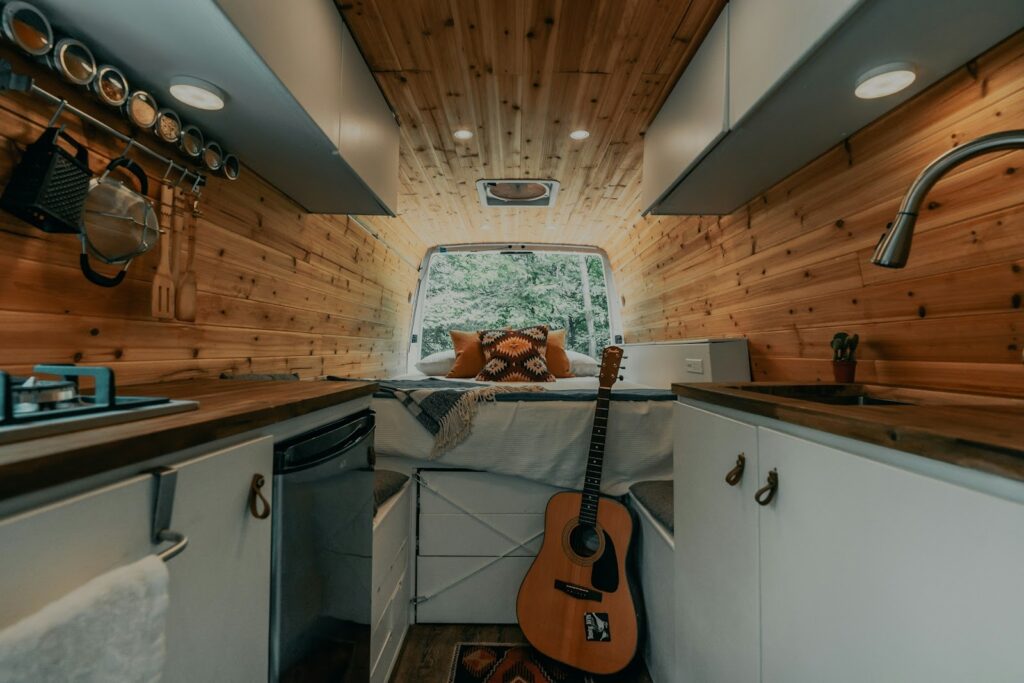
Photo by Clay Banks on Unsplash
Planning an escape from the noise, the crowds, and that wedding photographer cousin who won’t stop live-streaming your breakfast? Off-grid living demands more than just solar panels and compost toilets.
It thrives on gear you didn’t know mattered until your backup pump hiccups or your water filter sputters. In 2024, demand for survival and off-grid supplies rose by 23% in the U.S., and interest keeps rising as people seek independence and resilience source.
You’ll need more than basics: reliable gear, smart habits, and a few surprise essentials that turn a roughing-it experiment into a sustainable lifestyle. Let’s dig into those off-grid must-haves.
1. Trusted Multi-Fuel Stove with Backup Fuel Options
A camp stove works great until the hotel-sized propane cylinder runs out. Off-grid, you need a multi-fuel stove that runs on wood, diesel, or kerosene. Think military-grade collapsible systems with steel burners and wind-resistant design. One stick of hardwood logs becomes your oven and grill. No more fingernail-sized flame from a portable propane unit.
Bonus joke: Cooking dinner over a propane fire feels fancy until you realize frozen burritos don’t defrost faster.
2. Solar-Assist Water Pump with Manual Crank
You might have a gravity-fed system, but solar clouds (or battery failure) can strike. Combine your setup with a manual hand-crank pump. A one-minute crank fills a liter, and that buffer prevents thirsty headaches. Choose a pump made of brass or stainless steel to avoid breakage when you most need water.
Iron-clad rule: In deserts, a gallon in the fridge means nothing if the pipes sit dry.
3. Gravity-Filter Water Systems
Portable filters that rely on gravity and carbon block microns provide continuous clean water without electricity. Set a 5-gallon container above a filter stand and let gravity do the work. No fuss, just steady filtered water.
Game on: When your neighbor hears your filter hum, they’ll think you set up a secret cafe.
4. DC-Powered Refrigerator with Thermostat
Solar fridges plug directly into a 12V solar battery bank. Hit that thermostat, and the unit maintains 32–40°F without AC electricity. Stick to compressor models. They use less power than thermoelectric ones. Keep refrigerated items safe, plants fresh, and dairy without worry.
Bonus: No more melting block of ice for morning coffee. No one loves slushy mush in their latte.
5. Off-Grid-Compliant Composter & Waste Separation System
Compost toilets work fine until your system smells. Add a dual-chamber compost bin with a vented toilet system that redirects leachate into a sealed tank. Compost older stuff upstairs in the bin, and safe waste stays separate.
That three-chamber pile in your yard doesn’t just compost. It cultivates next year’s veggie patch.
6. Rugged Mechanical Tools & Spare Parts Vault
Electric tools work well until batteries freeze or drain. A manual drill, ratchet-set, hand saw, and files will cover major fixes. Combine them with a spare parts kit: hoses, pipe clamps, pump seals, fuel filters, cutters, lighters, and tarp liners.
Still struggling? That’s why I keep a Zastava parts kit tucked away. Working on outdoor repair calls for dependable hardware even in remote setups. Check it: Zastava parts kits offer versatile attachment options for tool modification or field operations.
7. Thermal Mass Insulation: Closed-Cell Foam + Phase-Change Packs
Insulation matters in summer and winter. Closed-cell foam boards resist moisture and reflect heat. Pack phase-change cooling/heating blocks inside walls to regulate indoor temps without running fans or heaters.
In winter, they hold heat; in summer, they hold cool. At $10 per 8×4 sheet, these tabs keep you comfy 24/7. Cheaper than AC bills.
8. Efficiency Power Management with Monitors
Solar setups feel easy until you run out of power unexpectedly. Add digital solar monitors that track DC current in real time. These systems send phone alerts when usage spikes or storage runs low.
That way, your coffee-maker experiment doesn’t tank your phone or fridge battery.
9. Grain Grinder + Seed Vault Archive
Stockpiling flash freeze-dried food? Great, until it expires. Growing your own grain ensures fresh flour. Add a manual grain grinder and an airtight seed vault with heirloom wheat, rye, corn, and quinoa.
Fresh bread and nutrient-rich flour beat those 5-year MRE packs with their mystery powders.
10. Manual Launch Satellite or High-Mobility Internet Gear
Satellite connectivity does wonders off-grid. One carry-on package gives you 2 Mbps–12 Mbps upload/download. Pair it with solar panels and a 24V battery to keep the internet alive for critical calls.
Save it for emergencies or that weekend FaceTime with skeptical relatives who thought life ended off-grid.
11. Upholstered Shelter Hammock + Bug Net Combo
If you plan to garden, chill, or crash outside, invest in a cheery hammock with bug nets. It doubles as a lightweight shelter, shade, and bug-proof nap station without drilling new holes in your cabin.
Side note: Naps outside are more satisfying when your hammock doesn’t fall down at minute six.
12. Tool Belt and Field Ready Clothing Rations
Keep essentials on a tool belt: utility knife, LED pen light, multitool, notebook, high-V peanut butter bars. Plus, durable off-grid clothing: canvas pants, wool socks, chest holsters (if you carry tools).
Breakfast portable carbs keep energy high. No need to fire up a stove at 6 AM.
13. Forging Metal & Woodworking Corner
Off-grid repair depends on creative workshops. Combine an anvil, forging hammer, hardy block, wood vise, bamboo dowels, awls, and glue. Build brackets, renovate beams, and smith custom nails. Ancient but reliable.
Real mechanics live where creativity meets safety and nothing confirms independence like fixing a faulty nail with brass scrap at midnight.
Also Read: How a Wood Burning Stove Fireplace Insert Can Improve Heating Efficiency
Final Thoughts
Off-grid life isn’t just solar arrays, chicken coops, and Pinterest-level DIY décor. It thrives on smart gear that anticipates failure, builds resilience, and delivers comfort. You won’t need every niche tool listed here immediately. But once you hit a power shortage, a cold night, or a broken pipe, you’ll thank yourself.
So build that tools vault, install that grain mill, seal up phase-change walls, and maybe stash a Zastava parts kit for function and fun. Your off-grid retreat becomes a practical reality, not a fleeting fantasy.








